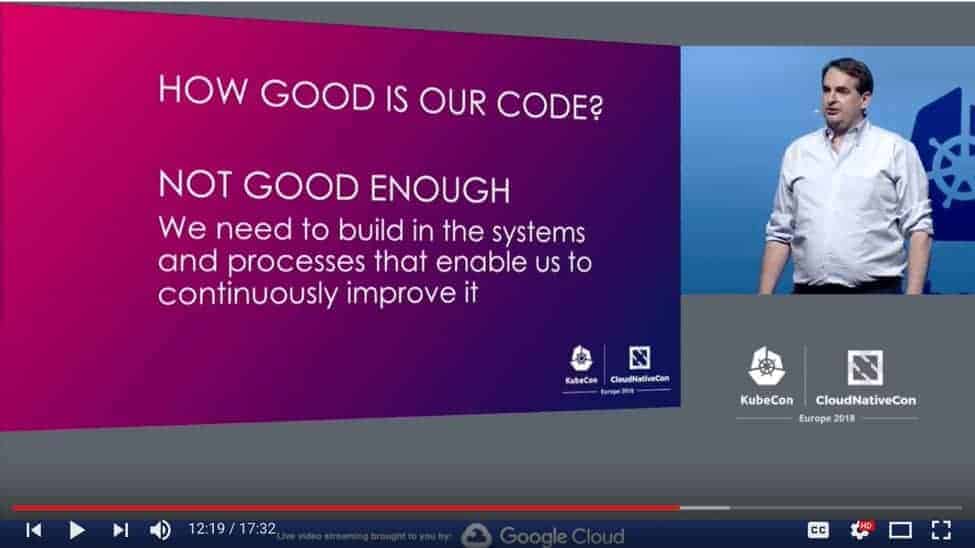More than 4,300 people gathered in Copenhagen May 2-4 for the biggest KubeCon + CloudNativeCon yet. Over three-plus days, attendees were engaged in more than 300 sessions, including four rounds of keynote addresses. Here are some highlights from those talks.

With the Kubernetes ecosystem growing by leaps and bounds, CNCF Executive Director Dan Kohn opened the conference by introducing the latest CNCF Interactive Landscape. His keynote also addressed the quality of CNCF’s code. His conclusion? Like all software, there are vulnerabilities. “It’s not good enough,” he said. But “the power of open source is the ability to leverage thousands of other developers that are finding bugs and making fixes to the software we depend on.” And continuous integration is the key step. (See the Cloud Native Trail Map that Dan referenced in his keynote here.)

CERN software engineer Ricardo Rocha, a member of the cloud team for the largest particle physics lab in the world, took the stage to describe the organization’s jaw-dropping scale: 320,000 cores, 4,300 projects, 250 Petabytes, 10,000 hypervisors, 210 Kubernetes clusters. With a presentation that included photos of CERN’s particle accelerator and Antimatter Factory, Ricardo was definitely a crowd favorite.

Brandon Philips, CTO of CoreOS, Red Hat, talked about Kubernetes-native applications, or operators, a concept his company introduced two years ago. “Imagine a cloud where you can install new applications on it,” he said. “We can extend Kubernetes and add whatever application we like.” Brandon announced that just before KubeCon, Operator Framework was launched: an open source toolkit to help developers build new operators and make them available to Kubernetes users.

The Financial Times spent almost a year migrating 150+ microservices to Kubernetes, while running its homegrown orchestration platform in parallel. Sarah Wells, the company’s Technical Director for Operations and Reliability, spoke of “spending your innovation tokens wisely” when making such a big move. In the end, theirs were spent wisely indeed; she reported that the company saw an 80% reduction in EC2 costs alone. And developers are happy, she said: “I haven’t seen any complaining on Slack about the new stack, which I think is a major achievement.”

One much-tweeted-about keynote addressed not what went right, but what went horribly wrong. Oliver Beattie, Head of Engineering of the U.K.-based startup Monzo Bank, offered a startlingly frank play-by-play of a recent outage. In great detail, Oliver explained how a bug in a gRPC client library affecting etcd, an incompatibility between Kubernetes and Linkerd—and human error—led to 1 hour and 21 minutes of cluster downtime. “While this was a really hairy outage for our engineers,” he said, “throughout this, the majority of payments did continue to succeed, and this is one of the core business metrics that we care the most about, that customers care most about.”
Plus, there were lessons learned: the value of defense in depth, chaos engineering, and more visible monitoring. Above all, the experience reinforced the importance of Monzo’s commitment to transparency. After the bank published a public postmortem, “The community really took it upon themselves to help us understand these issues and fix them,” said Oliver. “If we had not been forthcoming about what happened, I don’t think we would have benefited in this way. Embrace the community in every way you can.”

Weaveworks CEO Alexis Richardson offered his 2020 vision for cloud native in an inspiring (and appropriate for the location) Lego-themed talk. Now that Kubernetes has passed the startup phase, he said, “We want ubiquity—and we want people to build their own Legos on top.”
That translates into a cloud platform that businesses can utilize easily. It can run anywhere, has a multitude of components that can be sourced instantly, and can enable developers to simply say, “Just run my code.”
Pointing to the explosion of projects being discussed all around him at KubeCon, Alexis predicted that by 2020, these new tools will unify Kubernetes, containers, serverless, and managed services/APIs. High-velocity delivery pipelines will be enabled by GitOps, he said, which “empowers developers with operational control through making git the central of control.”
Finally, Alexis said to the developers in the audience, “It’s up to you to make this happen.” And he concluded with this strong message: “With this enormous power we’re being given with these tools, you have to use them responsibly. Diversity is table stakes. We have to act ethically and morally.”